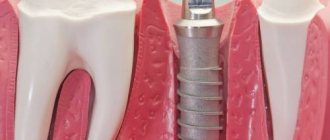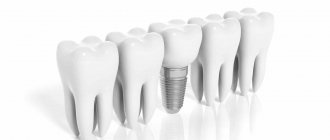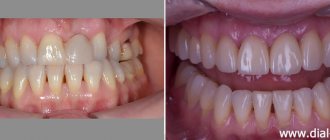Before deciding on dental implantation, patients want to know step by step how dental implants are placed.
The complete implantation procedure includes 3 stages:
- preparatory,
- surgical,
- orthopedic.
We have prepared a detailed description of each of them.
Why implantation?
All methods of dental prosthetics prior to implantation negatively affect the condition of the oral cavity in the future, often causing premature wear and loss of teeth. In particular, the manufacture of bridge-like prostheses - bridges, as they are also called - requires the depulpation and preparation of two, and sometimes three, teeth to replace just one lost tooth.
Such radical treatment, to put it mildly, is not beneficial for the jaw system and leads to overload of the supporting units with further root inflammation and tooth loss. At the same time, the average service life of “bridges” is 6-7 years.
The situation with removable dentures is even more complicated: for any removable device, the support is the gums and bone tissue of the jaw, which, in principle, is not adapted to a full chewing load. As a result, a chronic inflammatory process develops, and the bone atrophies and dissolves.
Alternative Methods
All options considered involve the implantation of screws into the bones. Nowadays all implantation materials are screwed in this way. An artificial metal root completely replaces the natural one. The implant has a similar appearance and is placed in almost the same area. Additional segments may be affected at greater depth.
Intramucosal technology for installing dental implants
The pin is not screwed into the bone structures, but directly into the gums and a little deeper. This way the installed structure will not fall out. Outwardly, it resembles buttons, and not an imitation of the root part of the unit.
The technique is gradually becoming a thing of the past due to its fragility. There is a high probability of complications (injury, inflammatory processes).
Endodontic-endosseous method
This option is also outdated. A device in the form of a small awl is inserted into the root canal, then it is moved slightly beyond its limits and fixed in hard tissues. It was used mainly in the presence of a mobile or broken incisor, canine, or molar. Such fixation is difficult to implement and becomes loose over time. The technology is not suitable for long-term restoration and is indicated for patients with narrow-shaped canals.
Mini implantation
How dental implants are inserted: tooth installation technology involves shallow immersion into bone structures. Over time, the pins become loose, the fastenings wear out, which means the prosthesis becomes mobile and causes severe discomfort.
This method is welcomed only as a short-term method while the patient is undergoing long-term therapy. For example, this happens when restrictions are discovered on the use of more “long-lasting” techniques. The treatment period is up to 5 days. The prosthetics are removable; screws can be inserted even in cases of complete edentia.
What to prepare for
Dental implantation is a technique that does not have the disadvantages of previous generations of prostheses. Implantologists consider it as the only way to restore lost teeth that does not harm the health of the oral cavity and has an unlimited (usually lifelong) service life.
Important! No other prosthetic method provides such high aesthetics as implantation.
But it should be taken into account that dental implantation is not a simple procedure during which an implant is simply inserted in place of the missing unit. The future tooth (more precisely, its root) must have a certain size, the proper position and direction, and a strictly defined inclination are selected for it.
In addition, it is necessary to restore all the tissue surrounding the tooth - and, first of all, bone tissue and gums. It is this comprehensive approach that allows us to achieve reliability, impeccable aesthetics, and durability of implant treatment.
Implantation is a slow process, except for one-stage implantation, as well as the “all on 4” and “all on 6” techniques. Treatment usually involves several stages, despite the common name of "two-stage" surgery.
Treatment always begins with diagnosis, which is the first and, perhaps, the most important stage that determines its outcome. Based on the results of the preliminary examination, a decision is made on implantation technology, types of implants, and the details of the upcoming operation are thought out.
Important! It is necessary to prepare for the fact that during the implantation process you will have to go through several stages. A standard scheme applies to all patients, so we have prepared a detailed description of each stage of dental implantation.
Dental implantation under anesthesia
Today, dental implantation is always performed under anesthesia. Local anesthesia is used and in some cases, when the operation is long and tedious, sedation is used. In some cases, general anesthesia may be used, but this usually occurs in rare cases where local anesthesia is ineffective.
It is believed that general anesthesia has some negative effects on the body and can worsen the survival rate of implants, so it is rarely used, making do only with local or combined anesthesia and sedation. In any case, the operation is completely painless for the patient and the period of return to normal after anesthesia takes a very short time.
The Dental Master clinic employs experienced, highly qualified implantologists, uses the most modern techniques and equipment, uses implants, components and instruments from the world's leading manufacturers, so implantation here is reliable, safe, effective and very economical.
Stage 1: diagnosis
It may take some time to choose a clinic and an implantologist, since this is one of the key points in the whole story. In addition, you need to get to know the orthopedist and, if necessary, the therapist - these doctors will also take part in the process of implantological treatment. If everything is satisfactory, then before implantation an examination is carried out by a surgeon.
He will tell you whether it is possible in principle to place an implant in this patient, and will develop further treatment tactics based on the following data:
- general oral health;
- the presence and condition of neighboring teeth and gums, which are located next to the future implant root;
- bite;
- hygiene quality;
- financial capabilities of the patient.
The price is usually included in the total cost of treatment, which is carried out in most clinics on a turnkey basis. The doctor will announce the approximate cost, the final price is determined after diagnostic testing and consultation with an orthopedist. If a patient needs the help of a physician, hygienist or periodontist, then their services should be considered.
Diagnostics includes instrumental and laboratory studies, without which surgery is impossible. These examinations are necessary to exclude a number of complications after the introduction of implant rods and achieve extremely good treatment results.
Compulsory health insurance program for citizens in Russia
Compulsory medical insurance guarantees free care in public clinics and hospitals. Medical insurance comes with territorial and basic programs. Basic policies apply to the entire territory of the Russian Federation. Territorial - only for the territory of a specific region. Such an insurance document determines the procedure for receiving free assistance to insured persons in a certain region of Russia.
Each region, region of the country has its own territorial compulsory insurance program. It is approved at a meeting of self-government bodies. The program is formed taking into account all the requirements recommended by the Ministry of Health. Provision of free services is possible only at the place of registration.
Dental services are also included in the compulsory medical insurance policy. Therefore, free dental care is available to every citizen. To get help, you need to go to a dental clinic or hospital. Have your insurance policy and identification document with you. At the reception, the patient fills out an application for choosing a medical organization and creates a medical record, which will contain all the information about the treatment. Afterwards, the patient is referred to a specialist for examination and further treatment.
Treatment covered by insurance is provided by some private clinics. To receive free help in a commercial clinic, a referral from a public clinic at your place of residence is required.
Patients are admitted and treated by appointment. It is impossible to get a scheduled appointment right away; you will have to wait about a week.
Without registration, appointment, queue and insurance, they accept patients in critical condition, with acute toothache, bleeding, high body temperature.
Instrumental studies – tomography and x-ray
They are performed on all patients, regardless of the chosen implantation technology. Based on the data obtained, the issue of the types of implants and the methodology of the implantation operation itself will be decided.
An X-ray is taken selectively, precisely in the part of the jaw where implants are planned to be installed. Using it, the doctor evaluates the condition and location of the roots of the teeth, near which the implant should be installed. The price of such a photo starts from 700 rubles.
A panoramic photograph is needed for any type of prosthetics, and implantation is no exception. Otherwise, it is called an orthopantogram and is performed to take into account the characteristics of the bite and the condition of the bone tissue. All this is of great importance, since a strong foundation is extremely important for the implant root.
The price of a 3D image - orthopantogram - from 1500 rubles.
But the most important study at the diagnostic stage is CT - computed tomography. Without it, not a single dental implantation operation is performed, and neither an X-ray nor an orthopantogram can replace it.
Computed tomography is the most expensive examination at the diagnostic stage, the price of which starts from 3,000 rubles. Based on its results, the quality of bone tissue is assessed, the sites for installing implants and their type are selected. It is the tomogram that allows the implantologist to conclude that bone grafting is necessary if there is insufficient bone volume.
Modern medical centers where implantation operations are performed are equipped with high-precision equipment and use navigation programs. All this makes it possible to plan the course of treatment in detail and even show its future results to the patient!
Lab tests
The diagnostic stage before implantation necessarily includes a general and detailed blood test. This is a must for everyone. Certain categories of patients will need to provide the results of hormone tests (usually women) and other specific laboratory tests if there are concomitant pathologies.
A number of diseases are a relative contraindication for surgery to install implants, and then a preliminary consultation with a specialist is necessary. If necessary, before implantation, the condition is corrected to acceptable levels (for example, in the case of diabetes).
The price of sample collection services may vary and depends not only on the number of studies. Many tests are done in district clinics, and will be free if referred by a doctor. Thanks to this approach, diagnostic costs can be significantly reduced.
At the diagnostic stage, all patient data is collected, and based on the information obtained, the optimal method of dental implantation and type of implants are selected. After agreeing on the finished plan with the client, we begin to implement it. Next begins the stage of preparation for the implantation operation.
What dental services are provided free of charge under an insurance policy?
- Consultation and examination by a specialist;
- treatment of caries if tooth decay is less than 50%;
- pulpitis;
- periodontitis;
- removal of tartar (up to six teeth) without the use of equipment at once;
- treatment of gingivitis, periodontitis, stomatitis with medications;
- splinting teeth during periodontal treatment;
- anesthesia;
- treatment of hypersensitivity of teeth.
All drugs, tools, and materials used are domestically produced.
Surgical dentistry under the compulsory medical insurance policy includes:
- specialist appointment;
- simple and complex removal of teeth (impacted, dystopic);
- anesthesia;
- excision of the hood due to difficult eruption;
- treatment of alveolitis with socket curettage;
- splinting of teeth in case of jaw fracture;
- opening of an abscess;
- removal of bony protrusions;
- removal of benign tumors.
of diagnostics are available under the policy :
- radiography and radiovisiography on film and paper;
- orthopantomography - for children and the privileged category of the population for prosthetics.
Physiotherapeutic treatments are also provided :
- phonophoresis;
- darsonvalization;
- galvanization;
- laser and magnetic therapy;
- inductometry.
Opinion of a dental surgeon : “The list of free services under the compulsory medical insurance policy in individual regions is different. In prosperous areas it is represented by two hundred items. In financially disadvantaged areas, dental services may account for 20-30 positions. Registers of medical services in different territories do not coincide and do not meet the requirements approved by the Ministry of Health of the Russian Federation. Veterans and disabled people cannot obtain preferential prosthetics. What can we say about pensioners? Due to the reduction of dental departments, it is very difficult to get care in some regions.”
Stage 2: preparatory
Details of the preparatory stage may vary significantly for different patients due to differences in the condition of the oral cavity in general and the jaw bone tissue in particular. Most people planning to have implants require dental hygiene.
Sanitation is carried out with the aim of eliminating bacterial plaque from the surface of tooth enamel, since a successful implantation operation requires, if not sterility, then maximum cleanliness of the oral cavity. The presence of pathogenic microflora can provoke the development of inflammation, which should be avoided at any stage of implantation.
Hygienic cleaning is done using ultrasound when there is existing tartar, soft plaque is removed using Air Flow technology. The price of such reorganization is from 6,000 rubles.
At the preparatory stage before implantation, it may also be necessary to remove teeth, treat caries and periodontitis. The price of each procedure is calculated separately.
But the most serious step before installing implants may be bone grafting surgery. Very often it is impossible to do without it due to a lack of bone due to its resorption - resorption, natural loss. Bone volume can be greatly reduced if a tooth is lost or removed long ago, or due to individual characteristics.
As a rule, bone grafting is performed in the case of classical two-stage implantation, which places high demands on the quality of the jaw bone tissue. In addition, bone grafting is almost always necessary for patients who have lost teeth a year or more ago. During this period, the bone undergoes rarefaction and becomes brittle, which creates certain difficulties with fixation of implant roots.
There are several methods for performing bone grafting, or osteoplasty, using different materials. Therefore, the price will depend on the selected operation technology. There are 3 options in total:
- sinus lift;
- directed regeneration;
- autotransplantation.
How to choose the right implant?
Today, dental clinics offer dozens of brands and models of dental implants. For most patients, the main factor when choosing implants is cost. It’s quite difficult to blame them for this. As already mentioned, the price difference between different models can be very large. For example, elite implants from Straumann or Nobel Biocare are on average more than twice the cost of implants produced in South Korea and Israel.
On the other hand, the survival rate of economical implants is also very high, since they are made from modern titanium alloys (for example, grade 4), and, as a rule, have a modern SLA coating, which helps ensure high-quality osseointegration. Economy class implants may well be recommended in standard clinical situations. This means that the doctor did not find any nuances that complicate obtaining a high-quality functional and aesthetic result.
It cannot be said that inexpensive implants “give in” to the slightest difficulties, however, in unusual situations, doctors most often recommend luxury implants. Thanks to advanced technological solutions that are designed specifically for implantation if the patient has certain limitations, the problem is solved better, and the doctor achieves a more predictable result.
Situations when it is better to use premium implants:
- implantation for bone deficiency;
- implantation in the presence of narrow interdental spaces;
- implantation of anterior teeth when achieving ideal aesthetics is required;
- The patient is allergic to titanium.
Sinus lift
Sinus lift or subantral augmentation surgery before implantation can only be performed on the upper jaw. Its essence is to raise the lower septum of the maxillary sinus in order to increase the space of the alveolar ridge. The space thus freed is filled with bone tissue.
On a note! Sinus lifting is scientifically called subantral augmentation.
If there are no contraindications, the implantologist can combine sinus lifting with the installation of implants. Otherwise, the latter are placed in the jaw bone 3-6 months after the subantral augmentation surgery.
Sinus lifting can be open or closed, and its price depends on the chosen method. Open operations are estimated at the amount of 40,000 rubles, closed ones - from 20,000 rubles. It is important to know that this cost does not include the price of the bone material itself.
Price
| Implantation system | AnyOne | AnyRidge | Astra Tech |
| A country | South Korea | South Korea | Sweden |
| Class | Economy | Standard | Premium |
| Implant material | Titanium Grade 4 | Titanium Grade 4 | Titanium Grade 4 |
| Implant warranty | for life | for life | for life |
| Implantation guarantee | |||
| Price | 16,500 rub. | 25,000 rub. | 55,000 rub. |
| Possibility of installation in installments | 0% | 0% | 0% |
| Implantation system | Osstem | Implantium | Nobel |
| A country | South Korea | South Korea | Sweden |
| Class | Economy | Standard | Premium |
| Implant material | Titanium Grade 4 | Titanium Grade 4 | Titanium Grade 4 |
| Implant warranty | for life | for life | for life |
| Implantation guarantee | |||
| Price | RUB 30,400 RUB 19,900 | 25,000 rub. | 55,000 rub. |
| Possibility of installation in installments | 0% | 0% | 0% |
Osstem implants
(South Korea)
25,000 rub.
RUB 19,900
More details
| Implantation system | Osstem |
| A country | South Korea |
| Class | Standard |
| Implant material | Titanium Grade 4 |
| Implant warranty | for life |
| Implantation guarantee | |
| Price | 25,000 rub. RUB 19,900 |
| Possibility of installation in installments | 0% |
Implantium implants
(South Korea)
25,000 rub.
More details
| Implantation system | Implantium |
| A country | South Korea |
| Class | Standard |
| Implant material | Titanium Grade 4 |
| Implant warranty | for life |
| Implantation guarantee | |
| Price | 25,000 rub. |
| Possibility of installation in installments | 0% |
Astra Tech implants
(Sweden)
55,000 rub.
More details
| Implantation system | Astra Tech |
| A country | Sweden |
| Class | Premium |
| Implant material | Titanium Grade 4 |
| Implant warranty | for life |
| Implantation guarantee | |
| Price | 55,000 rub. |
| Possibility of installation in installments | 0% |
Nobel implants
Sweden
55,000 rub.
More details
| Implantation system | Nobel |
| A country | Sweden |
| Class | Premium |
| Implant material | Titanium Grade 4 |
| Implant warranty | for life |
| Implantation guarantee | |
| Price | 55,000 rub. |
| Possibility of installation in installments | 0% |
Expert of the article you are reading: Zakharkin Maxim Borisovich Implantologist, orthopedist, dental surgeon, leading specialist of the NovaDent network
17 years
Clinical experience
Skhodnenskaya
Khimki Boulevard, 14, bldg. 2
+7
Get advice from this specialist
Autotransplantation (autologous transplantation)
Another type of bone grafting performed before implantation. It is essentially a self-transplant since the recipient is his own donor. A similar technique is used for extensive burns, when areas of the patient’s healthy skin are transferred to the burned areas.
A similar technology is widely used by implantologists. During surgery, bone blocks taken from the patient are implanted into the jaw bone. The recovery period after installing implants using autologous transplantation is quite long and can last up to six months.
Implantation of implant roots is possible after completion of osseointegration, after 6 months. The asking price is at least 50,000 rubles.
Promotions and discounts - when you can implant a tooth much cheaper
Implantation is not a cheap procedure. However, installing implants makes it possible to solve many problems within a short period of time. A full healthy life is impossible without teeth.
Many clinics work with budget systems, which makes the procedure more accessible . To attract patients, systems of discounts and special offers . Many private dental institutions are ready to offer promotions on implantable structures and their installation.
Prices for implantation during the promotional period can be reduced by up to 50%.
Stage 3: installation of implants
If bone grafting was performed, then the stage of dental implantation itself proceeds six months after the healing of the jaw tissue and successful integration of the bone. Surgical treatment for implantation of implant roots, in turn, is also divided into several stages, including:
- Stage 1 – pain relief. The type of anesthesia is planned at the diagnostic stage, and its choice depends on the scope of the intervention. When installing 1-2 titanium rods into the jaw, local anesthesia is usually given. If there are more, implantation may require general anesthesia or sedation;
- Stage 2 – incision of the gums and periosteum to gain access to the surgical field;
- Stage 3 – drilling a hole for the implant root in exact accordance with its dimensions and forming notches on the walls of the hole for better fixation of the future tooth in the jaw. The prepared hole is treated with an antiseptic, dried, after which the implantologist begins to screw in the implant itself;
- Stage 4 – installation of a plug to prevent tissue from growing inside the implant root;
- Stage 5 – suturing the gums and suturing. Implantation is complete.
On a note! Implant sedation is often chosen by patients who experience panic attacks before dental treatment. It is also indicated for people with heart disease and hypertension. Sedation is a safer alternative to general anesthesia, which is advisable to use for multiple dental implantations and bone grafting.
After the implants are installed, the patient is under the supervision of a doctor for some time, who at the same time instructs him regarding further treatment and care. If there are no signs of complications, after a couple of hours the person goes home, where he takes medications to speed up the healing of the gums and stimulate the osseointegration of the implant roots. In addition, he is given a leaflet with recommendations regarding oral hygiene after implantation.
The sutures after implantation are usually removed after a week, then a temporary crown can be installed. The price of the main stage largely depends on the type of implants.
Honestly about the disadvantages of implantation
Despite the significant advantages - restoration of the chewing load on the bone and stopping the atrophy of bone tissue, the feeling of the implant as if it were your own teeth, excellent appearance, durability and reliability, no need to grind down adjacent teeth - implantation also has its own disadvantages, which we will consider in detail.
1. Pain after implantation. Installation of an implant (or implant - everyone pronounces a foreign word differently) is a surgical operation with all the ensuing consequences - including pain for some time after the operation. During the normal course of the process, the pain goes away within a few (3-5) days.
2. Possible complications. One of the most serious complications is material rejection - the body does not perceive a foreign object and tries to get rid of it. Inflammation, pain, swelling, implant mobility, fluid secretion and even increased body temperature. To be fair, let’s say that the probability of such an outcome is very low - it is only 2-3% of the total number of people who have implants installed.
3. Presence of contraindications. Implantation, like most all medical procedures, has contraindications – situations in which it is impossible to install implants. These include: age under 20 years, diabetes mellitus (type 2), hepatitis, AIDS, other immune and cardiovascular diseases, bleeding disorders, bruxism and some others. Some of the contraindications can be circumvented, others cannot.
4. Long installation process. The installation itself can be carried out in literally 1-2 visits to the dentist, but the total period of engraftment of the artificial root can take from 6 months to 1-2 years. But in case of a favorable outcome (and this, we remind you, is 97-98% of all cases), you will have the same tooth as before, which will serve you without any problems for 10-20 years, or even more.
5. Caring for implants is more complicated than regular teeth, although not by much. They need to be cleaned more thoroughly, and you also need to regularly visit a dentist, who should monitor the condition of the implant and take timely measures if any problems suddenly arise.
6. The cost of implantation is very high. Prices for installing one implant start from 18,000 rubles - and this does not include the cost of the crown. In other clinics (especially in the capital), the total cost of a new tooth can exceed 100,000 rubles or more.
Still, the pros outweigh the cons in most cases. Otherwise, implantation would not be used so widely, and this technology, for a moment, is already more than 55 years old. The first operation was successfully performed by the developer of this technology and the founder of Nobel Biocare (which is still a leader in the scientific development and production of implants) Per-Ingvar Brånemark back in 1965.
Since then, millions of operations have been performed all over the world, several more large companies have appeared producing implants, instruments and components, implants of a more advanced form and from the latest, biocompatible materials have been proposed, the technology has been developed to perfection, and research into the consequences of implantation has become the most extensive nature, including many thousands of patients observed over decades. But still, let’s return to the disadvantages of implantation and analyze them more carefully.
Stage 4: rehabilitation after implant installation
The rehabilitation period is the time during which the implant root takes root in the patient’s own tissues. Only after osseointegration is completed can one proceed to the orthopedic stage and place permanent crowns.
It is impossible to shorten the healing time of implant roots, even if you take special calcium supplements and other medications. Depending on individual characteristics, it can average 3-6 months, although in most cases it takes at least six months.
The implantologist may recommend regular visits to the clinic to monitor the survival of the implant root (or roots). However, in the absence of discomfort and complications at the rehabilitation stage, the patient makes the next visit to the clinic at the very end. Next, a date is set for placing a gum former on the implant.
How is dental implantation performed?
Implantation is a complex surgical procedure. It works like this:
- Preparation. The doctor at the NovaDent clinic collects anamnesis and conducts an examination. This allows us to identify possible contraindications and determine what the cost of dental implants in Moscow will be in this case;
- surgical stage. The implant is implanted into the patient's jaw under anesthesia. The wound is sutured. After a set period of time, the sutures are removed. The gum former is installed, and then the abutment;
- orthopedic stage. Based on the casts, a prosthetic structure is made, which, after complete engraftment of the pin, is installed in the patient’s oral cavity.
Our dentistry has its own dental laboratory. This allows you to speed up the process of making dentures and at the same time get the best results.
Stage 5: insertion of the healing abutment
This detail is necessary to give natural contours to the gums in the operated area. The former is screwed directly into the implant rod by cutting the soft tissue.
In essence, the plug is replaced, which is unscrewed, and a former is placed in its place in the implant channel. The manipulation is very simple and quite fast. An experienced implantologist performs it in a matter of minutes, maximum in half an hour, regardless of the type of implant. But an anesthetic injection is still given due to the incision of the mucous membrane.
This is where the main and most serious part of dental implantation ends, and after a week or two they move on to screwing in the abutment.
Service life and how to care for implants
The service life of high-quality implants ranges from 10 to 25 years or for life. A low-quality implant may be rejected after 1-5 years, and it is not always possible to replace it.
It is not always possible to understand that a structure requires replacement. In some cases, the patient begins to be bothered by obvious symptoms - the gums rise or swell, and hurt. In others, the pathology is noticed by the doctor during an examination. Dentists recommend visiting a doctor annually for preventive purposes, even after restoration of the entire oral cavity.
Possible reasons for the end of the implant’s service life:
- injury;
- design rejection;
- peri-implantitis.
The service life of crowns depends on the material from which it is made. A plastic crown will last only 2-3 years, and a metal-ceramic crown will last 10-15 years.
To minimize the likelihood of complications, follow these recommendations:
- Be responsible when choosing a clinic and doctor. Sometimes it is better to overpay a little, but be confident in the high professionalism of the doctor. A common cause of construction failure is incorrect actions by the implantologist.
- Stop smoking. Cigarette smoke provokes mucosal irritation and inflammation, and damages crowns.
- Do not place excessive stress on the implant. Do not crack nuts with dentures or open bottles.
- Perform oral hygiene daily morning and evening, use dental floss throughout the day, and give preference to an electric toothbrush.
- Get an annual dental checkup and professional cleaning.
- Avoid facial injuries.
Following these rules will help you maintain a beautiful smile for many years.
Step 6: Abutment Installation
The abutment is screwed directly into the implant root; it is the abutment that is the connecting link between the implant and the crown/prosthesis. The abutment is installed 2 weeks after the former and is selected individually for each client.
For example, when implanting teeth in the smile area and thin gum tissue, it is recommended to install zirconium abutments, since titanium “spare parts” can negatively affect aesthetics.
Placement of the abutment completes the implantation procedure and treatment continues with the prosthodontist.
Contraindications
Dental implantation is a complex surgical operation that has a wide range of contraindications, both absolute and relative.
The procedure is completely contraindicated in the following cases:
- with severe mental disorders;
- for cancer of any origin;
- if a blood clotting disorder is detected;
- for severe autoimmune and rheumatic pathologies;
- for tuberculosis;
- for diabetes mellitus;
- for osteoporosis.
Relative contraindications include conditions that must first be cured, and only then think about surgery:
- caries;
- gingivitis, stomatitis;
- periodontitis;
- hormonal imbalance can cause pin rejection;
- pregnancy period;
- breastfeeding period;
- childhood;
- smoking, alcoholism and drug addiction;
- anorexia;
- insufficient oral hygiene;
- acute respiratory diseases;
- rehabilitation after injuries, operations, radiation therapy.
After eliminating the relative contraindication, implantation can be performed on the recommendation of the dentist.
Stage 7: prosthetics
After 1-2 weeks from the installation of the abutment, impressions of the teeth and jaws can be made. Crowns can be made from absolutely any material, but ceramic products are more suitable for front teeth. Implant roots in the area of chewing teeth are complemented by metal-ceramic or zirconium crowns.
The price of prosthetics varies depending on its type, since both crowns and removable, as well as conditionally removable dentures are placed on implants. In addition, the cost is affected by the material they are made of.
On a note! Zirconium is the most expensive, but also the most reliable material, which has high strength and excellent aesthetic qualities.
Indications
Indications for dental implantation:
- complete absence of dentition;
- missing one or more teeth;
- patient's reluctance or inability to use removable dentures;
- increased wearability of enamel;
- lack of closure of teeth.
The decision on the need to install pins is made by the dentist based on the results of a comprehensive examination.
Life after implantation
Once the implants have settled in and the crowns have been placed, it is important to properly care for them in order to maintain the results for as long as possible. The rules for caring for teeth with implant roots are standard, but with some peculiarities.
Firstly, you should use a brush with medium-hard bristles to avoid traumatizing the mucous membranes and ensure high-quality cleansing of new teeth. An implantologist or orthopedist will advise which paste is best to choose.
Secondly, it is advisable to rinse your mouth after every meal, but alcohol-based rinses are not suitable for this due to their ability to dry out the mucous membranes. A person with installed implants should have dental floss and an irrigator in their arsenal.
On a note! Insufficiently careful care of teeth on implants can shorten their service life and even lead to rejection.
How is rehabilitation going: what to do
The postoperative period is always accompanied by recovery measures that promote a speedy recovery.
In the first days, it is not recommended to even rinse your mouth. This will wash away the blood molecules that are responsible for wound healing. To maintain hygiene, you can gently clean, including the temporary crown. For this, soft brushes are used, and movements should be very smooth and careful. It is better to choose a paste with antiseptic additives.
Sauna, solarium, bathhouse, heavy lifting and excessive stress are completely contraindicated during this period. The appearance of any, even the most fleeting, unpleasant sensations indicates the need to see a dentist.
One-stage, instantaneous implantation
Dental implantation of teeth can be not only two-stage, but also one-stage, one-step. If you choose one of these procedures, the installation of implants will take much less time, at least due to the absence of the need to build up bone before implantation.
In one stage, implantation is performed in two cases: with satisfactory bone condition and the use of special types of implants. During surgery, the implant is installed, and a temporary crown is immediately placed.
Unlike one-stage implantation, one-stage implantation involves the simultaneous removal of a tooth and the introduction of an implant into the same hole. But, like one-stage, one-stage implantation is performed with immediate loading, that is, after installing the implant, an abutment is immediately screwed onto it and a temporary prosthesis is placed.
Important! A temporary prosthesis on an implant can be replaced with a permanent structure after six months.
Classic one-stage implantation is also called non-surgical express implantation. It has a number of advantages, since the client:
- saves time - implants are installed in one visit to the doctor;
- saves money - the final cost of one-stage implantation is lower than classical two-stage implantation;
- obtains excellent aesthetics even in the absence of most teeth - and in the case of complete edentia, a dazzling smile can be achieved within 3 days;
- recovers quickly after installation of implants, and with a lower risk of infection, swelling and other complications, since simultaneous implantation is performed without an incision or stitches.
Thus, implantation in one visit to the dentist is the best solution, since it allows you to do without bone augmentation, which means saving time, money and preserving your own bone tissue in the area of the implant root.
Start treatment at NovaDent
NovaDent is the perfect balance between professional medical care according to European quality standards and a comfortable price. “Best professional implantation” according to the National Council of Medicine - NovaDent deservedly holds the position of leader in the field of dental implantation in Moscow.
Sign up for a consultation right now and receive three treatment plans and a consultation with the clinic’s chief physician as a gift.










